T/F: Equivalents are the milliliters of a substance needed to balance 1 mole of an opposite, monovalent charge.
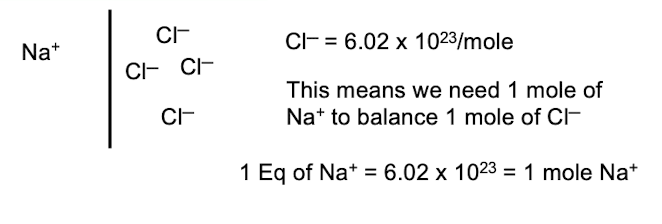
F
Equivalents are the MOLES of a substance needed to balance 1 mole of an opposite, monovalent charge.
T/F: Strong base slowly dissociates in water

F
T/F: Strong acid readily dissociates in water

T
T/F: [H+] does not vary a lot but [Na+] does

F
T/F: Urine pH can be as low as 4.5
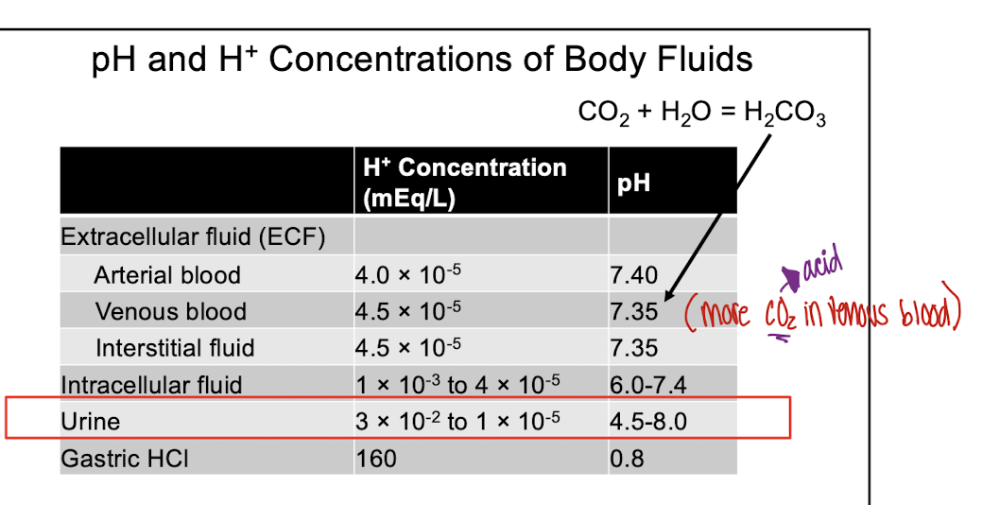
T
T/F: Buffering urine is essential for our physiological functions
F
T/F: Net uptake of acid from dietary source is 40 mmole/day
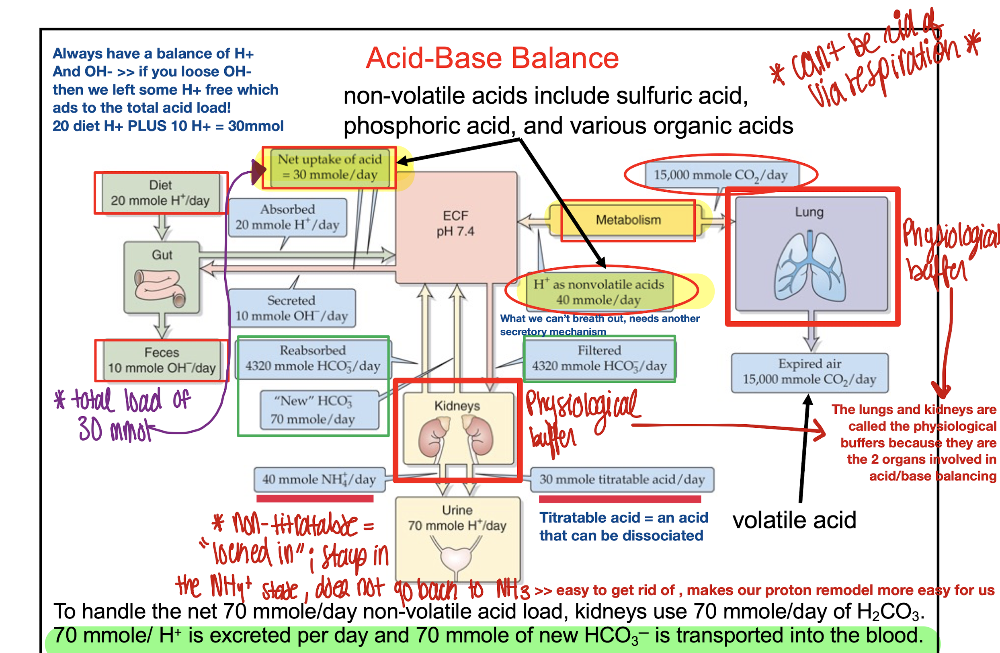
F
Net dietary intake is 20mmol/day
T/F: Non-volatile acids are removed from our body through expiration

F
They can't be breathed out and therefore need another secretory mechanism for removal
T/F: Alteration of [H+] influences rate of biochemical reactions, without affecting the distribution of other ions
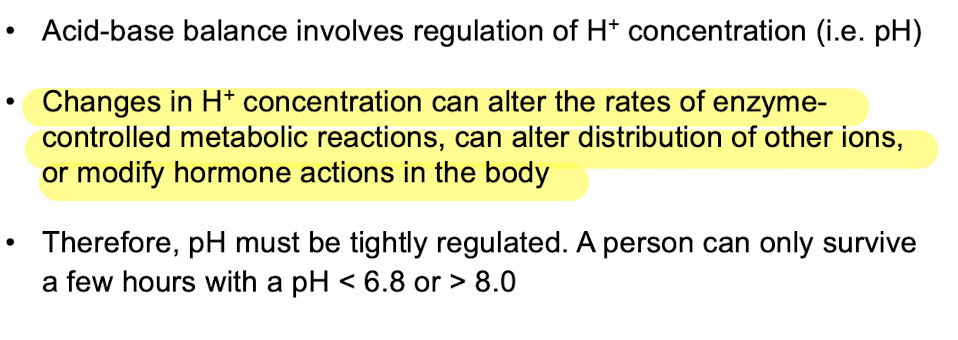
F
There WILL BE an alteration of the distribution of ions
T/F: Alteration of [H+] is momentarily corrected by respiratory system
F
What are the 3 primary systems to regulate h+ in body fluids?
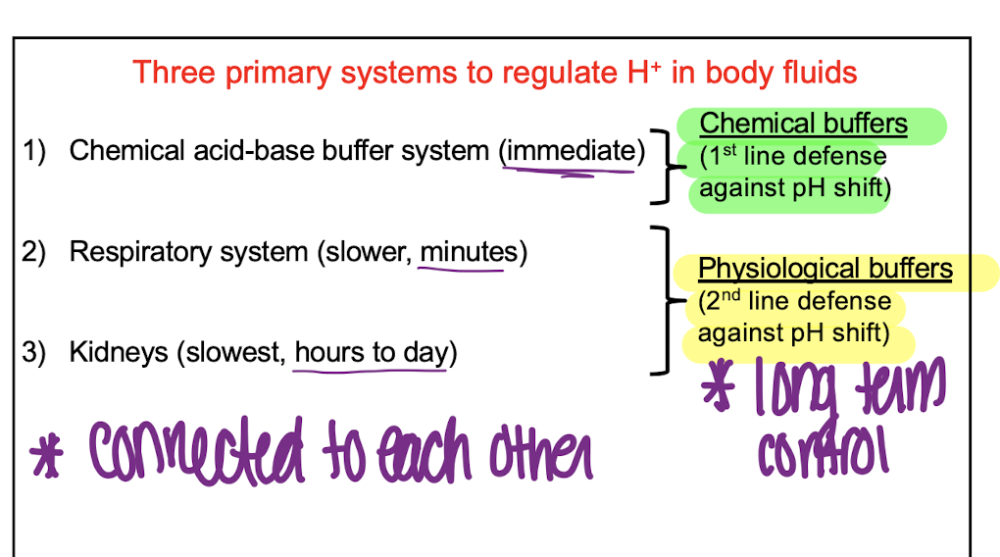
What are the 4 major Chemical Acid-Base buffer systems (immediate responses)?
(BPAP)
- Bicarbonate buffer system
- Phosphate buffer system
- Ammonia buffer system
- Protein buffer system
T/F: Bicarbonate buffer system is the most important system for buffering extracellular fluids (plasma)
T
Bicarbonate buffer system contains
- A weak acid (H2CO3)
- A bicarbonate salt (NaHCO3)
T/F: Phosphate and ammonia buffer systems are important in renal tubules
T
- Phosphate = renal tubule and intracellular fluids
T/F: Proteins are involved in majority of chemical buffering in body fluids
T
Protein buffer system is the MOST PLENTIFUL BUFFERS In the body and important for intracellular fluid buffering
What happens to CO2 levels when buffering bases?
CO2 levels decreased - leading to decreased respiration
Buffer Power is dependent on what 2 factors?
- pKa of the buffer
- Concentration of the buffer in the system
T/F: When buffering strong acid, CO2 level increases
T
Leads to increased expiration
Which of the following statements is not true about acid-base balance?
A.Net uptake of H+ through GI system is 30 mmole/day
B.Non-volatile acids are removed from our body through kidneys
C.Alteration of [H+] is momentarily corrected by respiratory system
D.Buffering urine is not essential for our physiological functions
C.Alteration of [H+] is momentarily corrected by respiratory system
Q. All of the following statements are true about bicarbonate buffer systems EXCEPT:
A.CO2 levels increase when buffering acids, leading to decreased expiration
B.CO2 levels decrease when buffering bases, leading to decreased respiration
C.Generated HCO3- remains in the system, but HCO3- salts are excreted by the kidneys
D.Carbonic anhydrase is not present in the blood plasma so the formation of carbonic acid is very slow in plasma
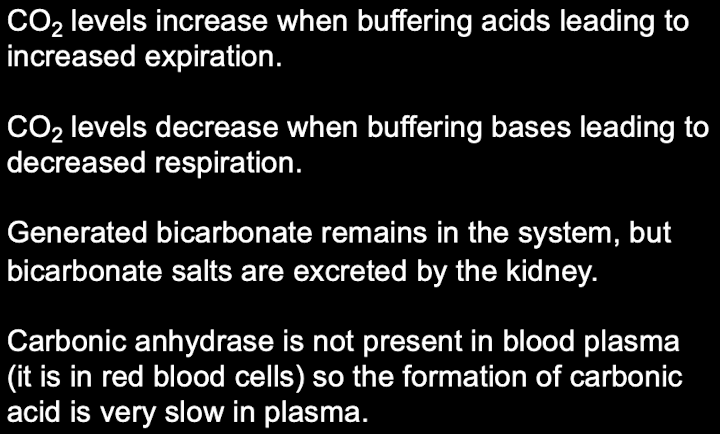
A.CO2 levels increase when buffering acids, leading to decreased expiration
A DECREASE in ventilation rate = ___________ in pCO2
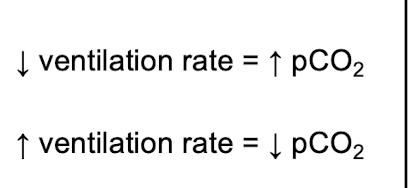
INCREASE
AN INCRESE in ventilation rate = ______________________ in pCO2

DECREASE
Doubling the ventilation rate increases pH by how much?
0.23
Q. Which of the following is/are paired with the correct rate?
A.Chemical acid base buffer systems: slower, minutes
B.Kidneys: slowest, hours to days
C.Respiratory system: immediate
D.A and B

B.Kidneys: slowest, hours to days
T/F: We vary urine pH within 4.5 – 8.0 so that we can maintain blood pH within the narrow range of 7.35 – 7.45.
T
Q. Which is the most important system for buffering extracellular fluids?
A.Phosphate buffer system
B.Bicarbonate buffer system
C.Ammonia buffer system
D.Protein buffer system
B.Bicarbonate buffer system
Q. Ammonium ion (NH4+) is best described as what kind of acid?
A.Volatile acid
B.Titratable acid
C.Non-titratable acid
D.None of the above
C.Non-titratable acid
Q. Which of the following is NOT true about ammonia buffer system?
a.NH4+ is a non-titratable acid
b.Ammonia buffer system is important in renal tubule
c.Ammonia buffer system generates new HCO3─
d.Conversion of NH4+ to NH3 can easily take place at urine pH
d.Conversion of NH4+ to NH3 can easily take place at urine pH
False, because NH4+ is non-titratable meaning it is irreversible
Q. Which major system is the most plentiful in the body and important for intracellular fluid buffering?
A.Bicarbonate buffer system
B.Phosphate buffer system
C.Protein buffer system
D.Ammonia buffer system
C.Protein buffer system
Intracellular proteins account for 60-70% of chemical buffering in body fluids. Highest concentrations in intracellular fluid. Not very good buffers in urine.
Q. Which of the following statements is incorrect regarding the phosphate buffer system?
A.This buffer system uses H2PO4- and HCO3-
B.Phosphate buffer system plays an important role in buffering renal tubule and intracellular fluids
C.Phosphate is important in renal tubules because it is greatly concentrated there
D.Phosphate buffer system is not the most important buffer system in blood
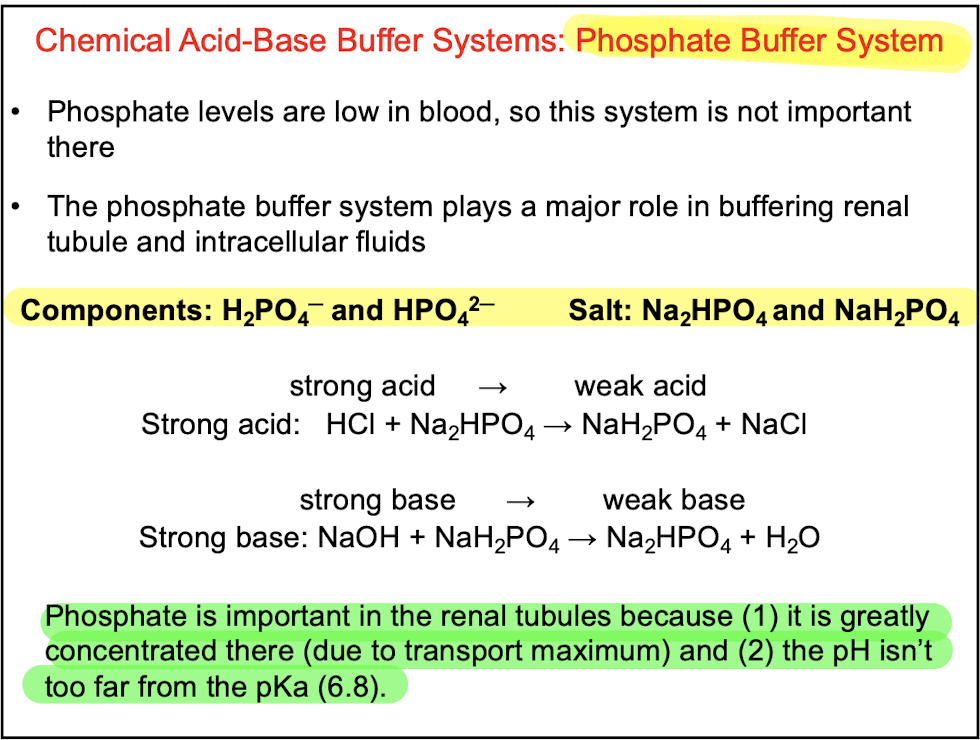
A.This buffer system uses H2PO4- and HCO3-
Q. What is the important buffering system in the renal tubules that is subject to physiological control?
A.Bicarbonate buffer system
B.Phosphate buffer system
C.Protein buffer system
D.Ammonia buffer system
D.Ammonia buffer system
Components: NH 3 and NH 4 + , a mechanism for making new HCO3 -
Q. CO2 levels increase when buffering acids leading to ______________ expiration.
A.increased
B.decreased
C.no change
D.none of the above
A.increased
Q. Which of the three primary systems that regulates H+ in body fluids is the slowest?
A.Chemical acid-base buffer system
B.Respiratory system
C.Kidneys
D.B and C
C.Kidneys
Kidneys control acid-base balance by excreting either basic or acidic urine
Q. All of the following are mechanisms by which extracellular H+ is regulated EXCEPT:
A.Production of new H2PO4-
B.Secretion of H+
C.Reabsorption of filtered HCO3-
D.Production of new HCO3-

A.Production of new H2PO4-
- Filtered HCO3- can be excreted if ECF pH is too ______
- Secreted H+ can be excreted if ECF pH is too ____
- too HIGH
- too LOW
To remove the 70 mEq of H+ generated by the body each day, we would need to excrete more than _________ of urine a day
2300 L
The kidneys can excrete H+, as much as 500 mEq/day, using buffers
Filtered load of HCO3 - is _______ moles/day
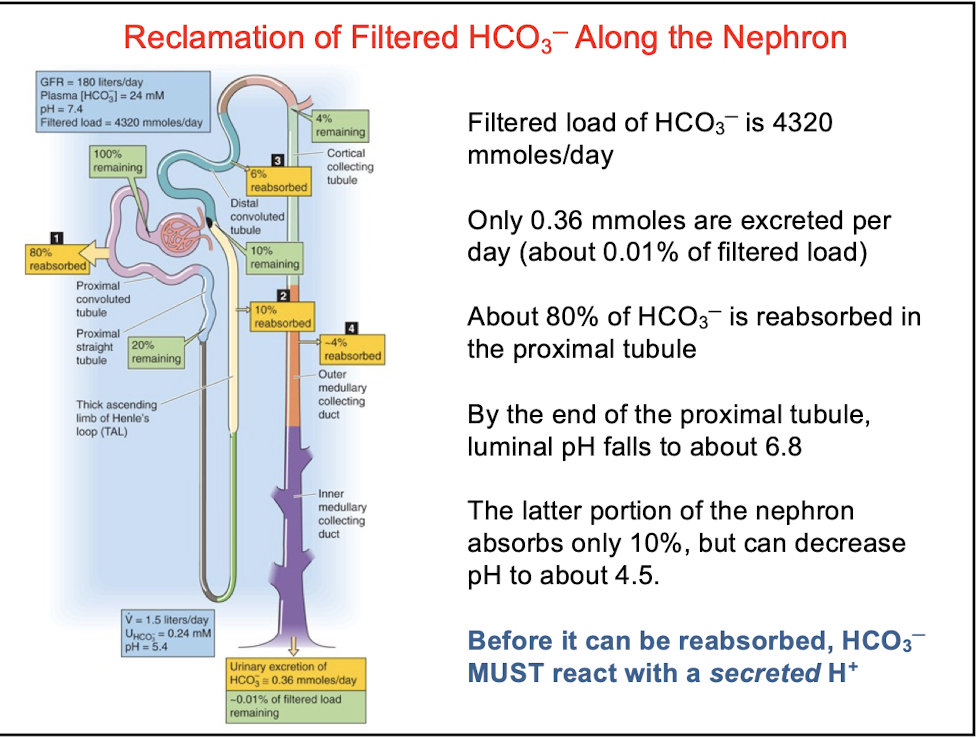
4320
Only __________ moles are excreted per day along the nephron

0.36
About _____ of HCO3 - is reabsorbed in the proximal tubule

80%
reabsorption of HCO3 - requires secretion of H+ = one H+ secreted into the lumen > one HCO3 - enters the blood
The 2 major mechanisms for HCO3 - regeneration along the nephron?
- Phosphate buffer system, uses H2PO4 - (not lipid soluble, excreted) and HPO42- (lipid soluble, reabsorbed)
- Ammonia buffer system, ammonia is Made within the tubule cells from glutamine and can be regulated. For every glutamine molecule metabolized, two NH4+ are secreted into the lumen and two HCO3 - are reabsorbed into the blood.
_____________ is the primary pH buffer in normal urine
Phosphate
INCREASING phosphate in urine will _______________ urine acidity
increase
Phosphate is reabsorbed by what kind of transporter?
Na+/phosphate transporter
Q. What is the function of Type B intercalated cells of the collecting ducts? Select All that apply
A.HCO3- reabsorption
B.H+ reabsorption
C.HCO3- secretion
D.H+ secretion

B.H+ reabsorption
C.HCO3- secretion
Q. A decreased ventilation rate is a compensatory mechanism for:
A.Decrease in pCO2
B.Increase in HCO3-
C.Increase in pCO2
D.Decrease in HCO3-
B. Increase in HCO3-
Q. Which of the following is NOT a major three primary buffer systems to regulate H+?
A.Chemical acid base buffer system
B.Respiratory system
C.Kidneys
D.Phosphate buffer system
D.Phosphate buffer system
Q. How will the presence of a strong acid affect ventilation when using the HCO3- system?
A.Hyperventilation
B.Hypoventilation
C.Normal ventilation
D.None of the above
A.Hyperventilation
Q. CO2 levels ________ when buffering strong bases leading to a/an __________ in respiration.
A.increase, decrease
B.decrease, decrease
C.increase, increase
D.decrease, increase
B.decrease, decrease
T/F: Increases in CO2 decrease alveolar ventilation
F
T/F: Buffering strong acids increases alveolar ventilation
T
T/F: Decreases in CO2 decrease alveolar ventilation
T
T/F: NH4+ is a titratable acid
F
T/F: Ammonium buffer system reduces HCO3- in the body
F
T/F: Protein buffer system makes new HCO3-
F
Ammonia buffer system makes the new HCO3 -
T/F: Phosphate buffer system is an example of physiological buffer
F
T/F: For every HCO3─ to be reabsorbed, it must react with a secreted H+
T
T/F: Type A intercalated cells secrete HCO3─

F
T/F: Type B intercalated cells reabsorb H+

T
T/F: Type B intercalated cells have HCO3─/Cl ─ transporter on the apical membrane H+

T
T/F: Type A intercalated cells have H+ pump on the apical membrane H+:

T
T/F: Phosphate buffer removes one H+ while reabsorbing one HCO3─
T
T/F: Glutamine breakdown in the renal tubules removes one H+ and produces one HCO3 -
F
For every glutamine molecule metabolized, two NH4+ are secreted into the lumen and two HCO3 - are reabsorbed into the blood.
In Acidosis: H+ secretion is _________________, HCO3 - reabsorption is ____________, titratable acid and NH4 + are ______________, no new ______ is made.
H+ secretion is decreased, HCO3 - reabsorption is incomplete, titratable acid and NH4 + are not excreted (no excess H+), no new HCO3 - is made
In alkalosis: H+ secretion allows ________ of HCO3 - , ________ of NH4 + and titratable acid, adding new __________ to the body
H+ secretion allows reabsorption of HCO3 - , excretion of NH4 + and titratable acid, adding new HCO3 - to the body
What are the respiratory acid-base disturbances related to pCO2 levels?

What are the metabolic acid-base disturbances related to intracellular HCO3 - levels?

Diagnosis of disturbances in Acid-Base Balance: relationship between pCO2 and HCO3 - (not a question, just a lecture slide)
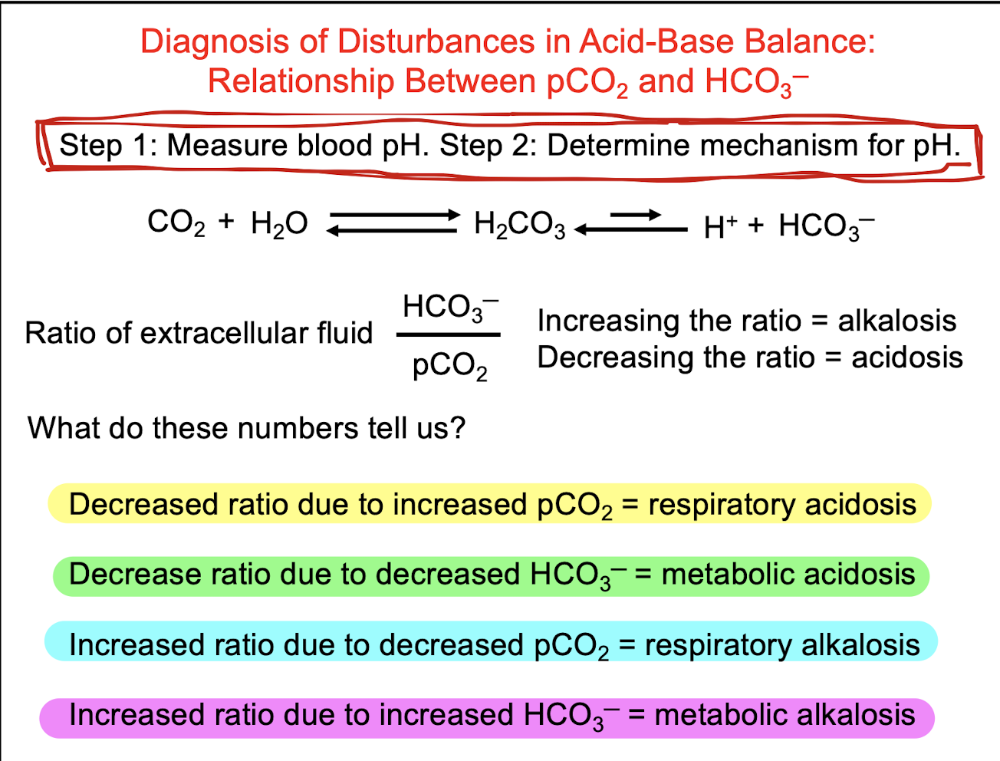
T/F: HCO3─ increases in metabolic acidosis
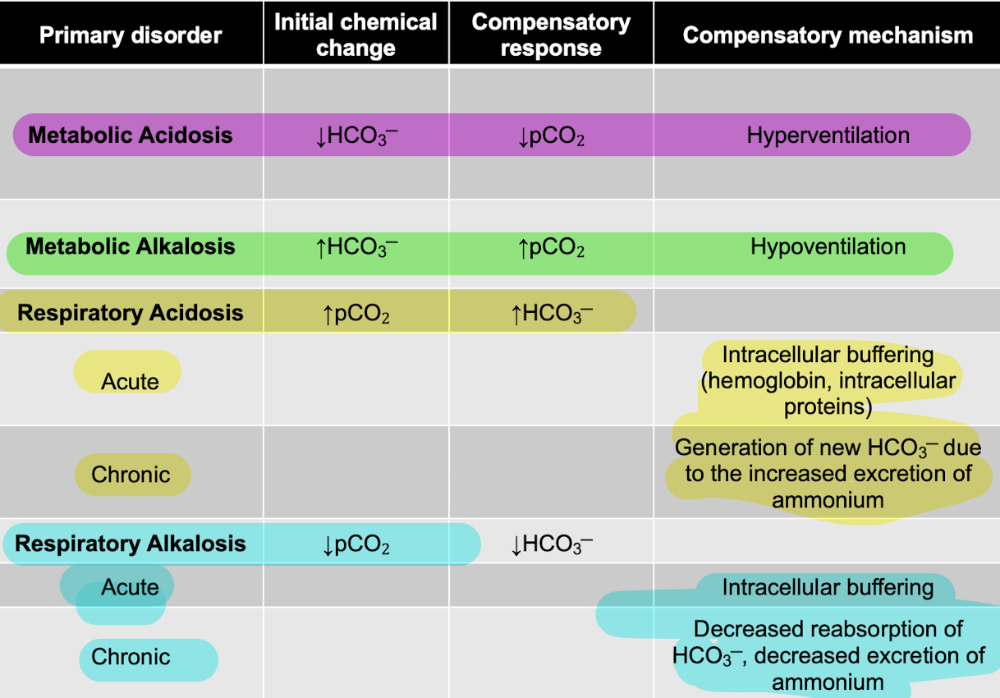
F
The body must maintain electroneutrality, meaning what?
the Total concentration of cations in the serum must equal the total concentration of anions
[Na+] + [UCs] = ([Cl-] + ]HCO3 -]) + [UAs]
- UCs = unmeasured cations
- UAs = unmeasured anions
What is the Anion gap ?
The difference in the serum (plasma) concentrations of the "measured" cations and anions
- essentially represents the missing anions and cations that cannot be measured
- useful in determining the cause of metabolic acidosis
- high anion gap is usually the result of accumulated anions such as lactate
Causes of Elevation Anion Gap:
- KULT
- MUDPILES
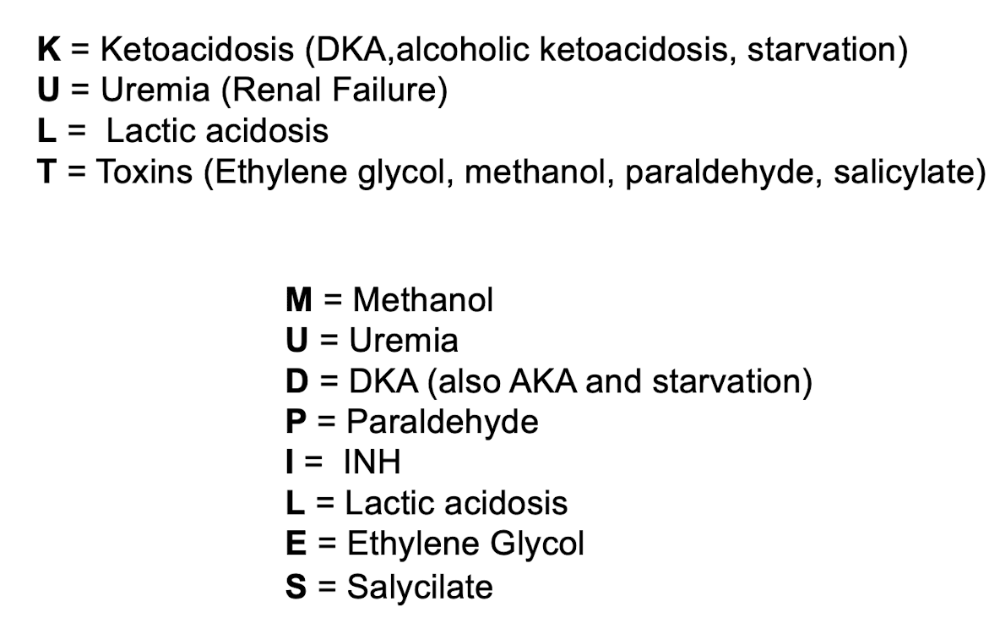
What is the Anion gap equation?
Anion gap = [Na+] – ([Cl-] + [HCO3 -])
T/F: The end result in type A intercalated cell action is one H+ ion secreted into the lumen and bicarbonate reabsorbed into the blood stream.
True
Q. Type B intercalated cells in the collecting duct secrete one _______ into the lumen and reabsorb one______ into the bloodstream
a.H+, HCO3─
b.HCO3─, K+
c.HCO3─, H+
d.NH3, H+
c.HCO3─, H+
Q. Choose the correct statement as it relates to pH and ventilation.
A.As blood pH decreases, alveolar ventilation increases
B.As blood pH increases, alveolar ventilation increases
C.As blood pH decreases, alveolar ventilation decreases
D.As blood pH decreases, alveolar ventilation stops
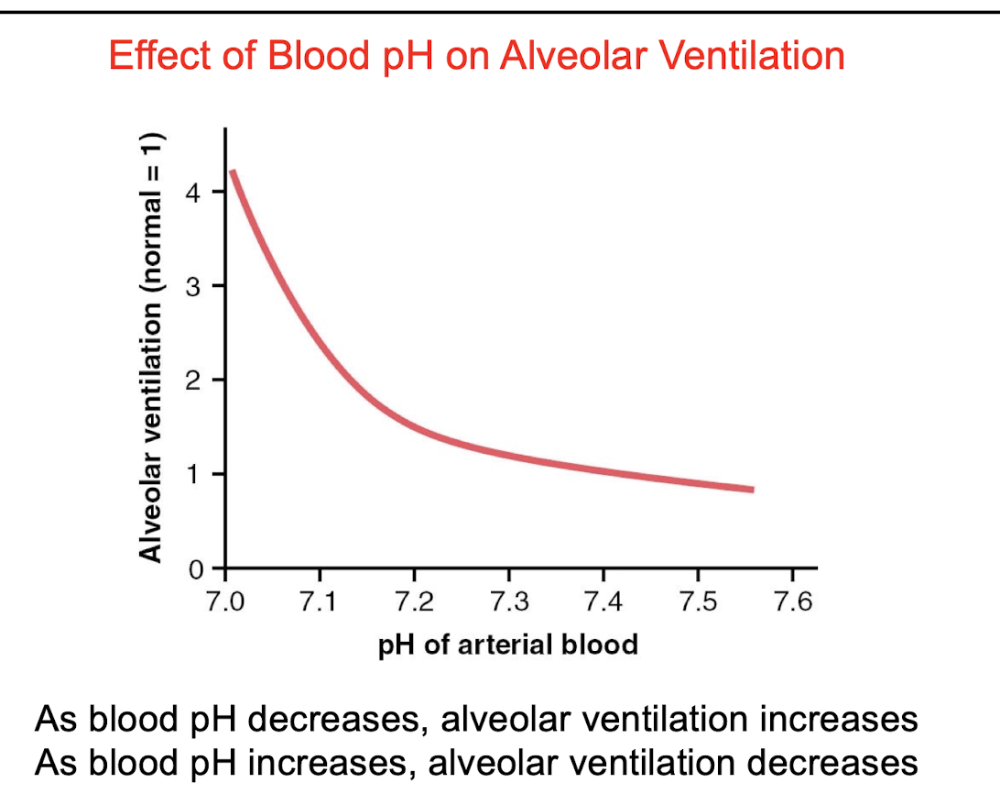
A. As blood pH decreases, alveolar ventilation increases
Q. Which buffering mechanism(s) removes non-volatile acids and generates HCO3-?
A.Phosphate
B.Bicarbonate
C.Ammonia
D.Protein
A.Phosphate
A. Ammonia
Q. Which of the following are the PRIMARY mechanisms by which the kidneys can regulate blood pH? (Select all that apply)
A.Secretion of H+
B.Reabsorption of H+
C.Production of new HCO3-
D.Reabsorption of filtered HCO3-

A.Secretion of H+
C.Production of new HCO3-
D.Reabsorption of filtered HCO3-
Q. All of the following are the causes of elevated anion gap except:
A.Uremia
B.Ketoacidosis
C.Lactic acidosis
D.Hyperchloremia

D.Hyperchloremia
Q. What is metabolic acidosis?
a.increase in CO2 level in the body
b.decrease in CO2 level in the body
c.increase in HCO3─ level in the body
d.decrease in HCO3─ level in the body

d.decrease in HCO3─ level in the body
Q. Metabolic acidosis results from a(n) __________ in blood pH due to decreased bicarbonate levels. To compensate for this change in pH, carbon dioxide levels will __________ through __________.
a.increase, decrease, hyperventilation
b.decrease, decrease, hyperventilation
c.decrease, decrease, hypoventilation
d.decrease, increase, hypoventilation

b.decrease, decrease, hyperventilation
Q. Which of the following mechanisms can cause alkalosis? Select all that apply.
A.excess addition of H+ to the body fluids.
B.excess removal of H+ from the body fluids
C.excess addition of HCO3- to the body fluids.
D.excess removal of HCO3- to the body fluids.
B.excess removal of H+ from the body fluids
C.excess addition of HCO3- to the body fluids.
Q. For every glutamine molecule catabolized, ___________ are secreted into the lumen and__________ are reabsorbed into the blood.
A.1 NH4+, 1 HCO3─
B.2 NH4+, 2 HCO3─
C.2 H+, 2 HCO3─
D.1 H+, 1 HCO3─
B.2 NH4+, 2 HCO3─
Q. Which buffer system(s) removes H+ and generates HCO3─? Select ALL that apply
a.Bicarbonate buffer system
b.Ammonia buffer system
c.Phosphate buffer system
d.Protein buffer system
b.Ammonia buffer system
c.Phosphate buffer system
Q. What is the correct equation used to describe the anion gap?
A.[Na+] + ([Cl-] + [HCO3-])
B.[Na+] + ([Cl-] - [HCO3-])
C.[Na+] - ([Cl-] + [HCO3-])
D.[Na+] - [Cl-] - [HCO3-]
C.[Na+] - ([Cl-] + [HCO3-])
D.[Na+] - [Cl-] - [HCO3-]
Q. Which of the following is consistent with metabolic acidosis?
a.Decreased HCO3 -
b.Increased unmeasured anions
c.Increased anion gap
d.All of the above
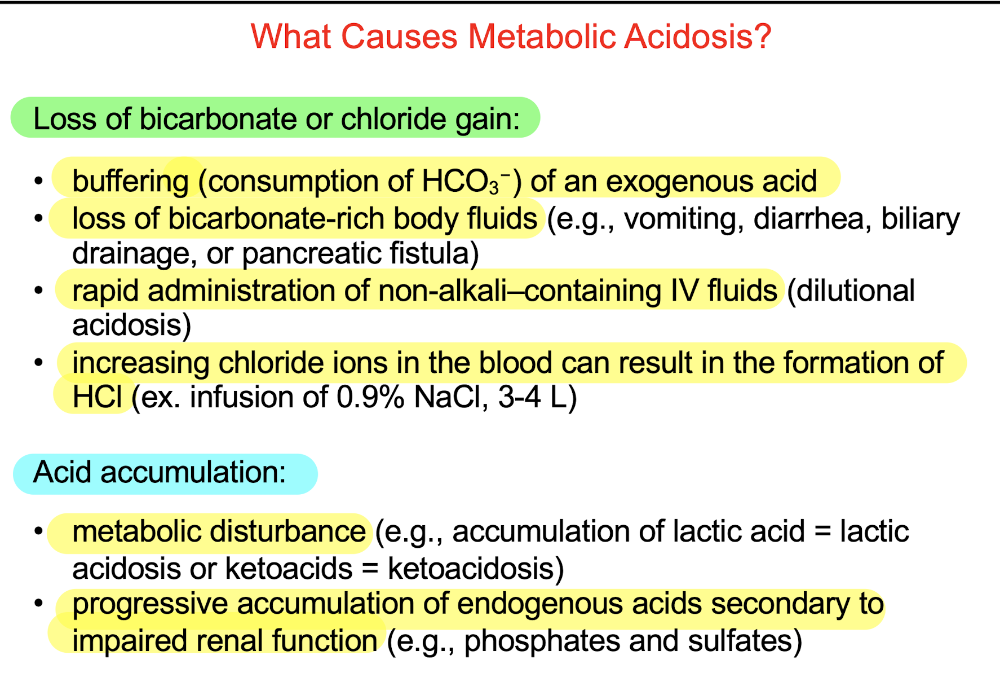
d.All of the above
Q. With bicarbonate buffer system, what happens to levels of CO2 when buffering a strong acid to a weak acid? What happens to expiration?
A.Increase, Increase
B.Decreases, Increase
C.Decrease, Decrease
D.Increase, Decrease
A.Increase, Increase
Q. What happens to pCO2 levels when a patient hypoventilates?
A.Remains the same
B.Increases
C.Decreases
D.Doubles
B. Increases
Q. What happens in the bicarbonate buffer system when excess amounts of NaOH are added to the system?
A.NaHCO3 formation and increased CO2
B.NaHCO3 formation and decreased CO2
C.Increased CO2 and H2O
D.No change in CO2 or NaHCO3 formation
B.NaHCO3 formation and decreased CO2
Q. There are three primary systems that regulate H+ in body fluids. Rank them according to the time it takes (slowest to fastest).
A.Kidneys - Respiratory - Chemical acid-base buffer systems
B.Respiratory - Kidneys - Chemical acid-base buffer systems
C.Respiratory - Chemical acid-base buffer systems - Kidneys
D.Chemical acid-base buffer systems - Respiratory - Kidneys
A.Kidneys - Respiratory - Chemical acid-base buffer systems
Q. When you have a serum anion gap value that is normal during metabolic acidosis, what is the likely status of chloride in serum?
A.Hyperchloremic
B.Hypochloremic
C.Normal values
D.There is no chloride present in blood
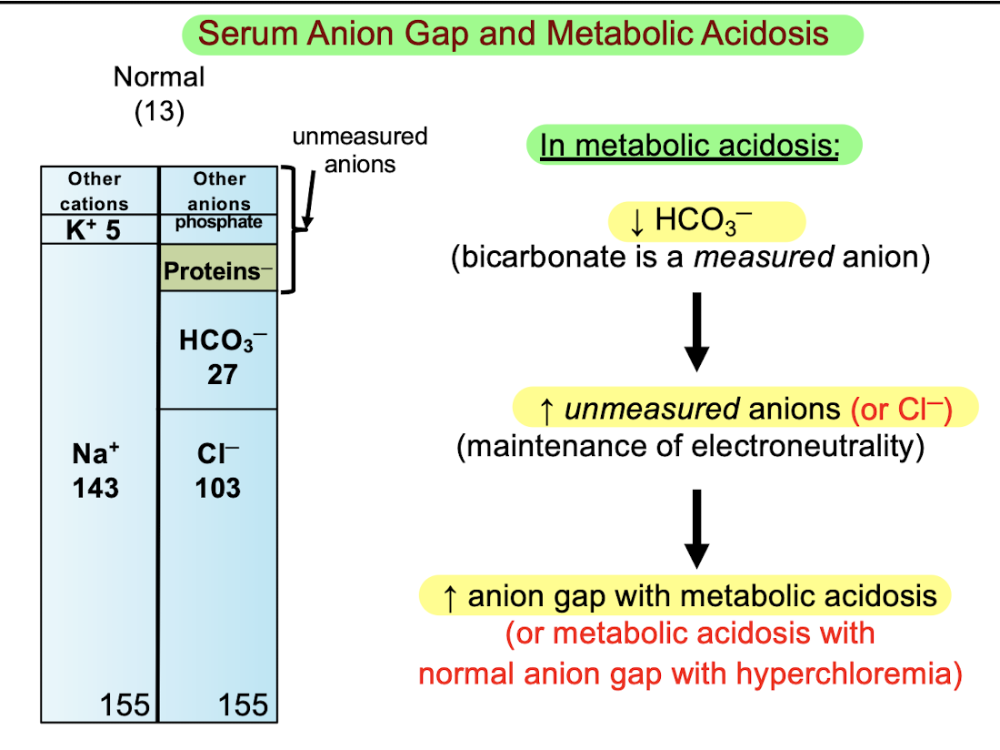
A.Hyperchloremic
Q. While the ______ buffering system accounts for the majority of the buffering in body fluids, the _______ buffering system is better at buffering plasma pH.
A.phosphate ; bicarbonate
B.ammonia; bicarbonate
C.protein; bicarbonate
D.bicarbonate; phosphate
C.protein; bicarbonate
Q. For the diagnosis of acid/base imbalance which of the following statements is FALSE when dealing with the ratio of extracellular fluid: HCO3-/pCO2 ?
A.Decreased ratio due to increased pCO2 = respiratory acidosis
B.Decrease ratio due to decreased HCO3- = metabolic alkalosis
C.Increased ratio due to decreased pCO2 = respiratory alkalosis
D.Increased ratio due to increased HCO3- = metabolic alkalosis

B.Decrease ratio due to decreased HCO3- = metabolic alkalosis
Q. All of the following are common with titration acidosis except:
A.HCO3- level decreases
B.Anion gap increases
C.HCO3- consumed by a noncarbonic acid
D.Cl- level decreases
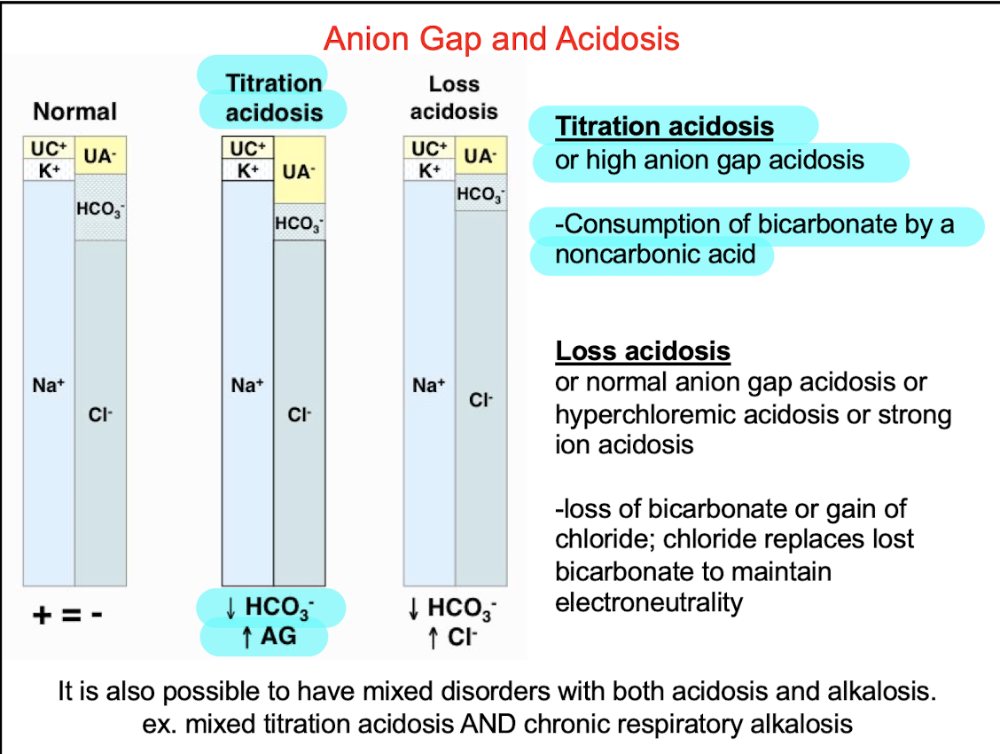
D. Cl- level decreases
Q. What is the compensatory mechanism of metabolic acidosis?
A.Hyperventilation
B.Hypoventilation
C.Intracellular buffering
D.Generation of new HCO3- because of ammonia excretion

A.Hyperventilation